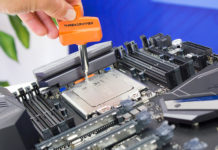We have taken a closer look at the first Athlon 64 FX processor with dual cores. FX-60 has to stand up to AMD’s earlier flagship but also Intel’s new nya dual core monster, Pentium Extreme Edition 955.
AMD has for the last couple of years been collecting successes with its Athlon64 processors with the FX models as the high end performance monsters. The FX processors have been granted unlocked multiplier and 1MB L2 cache,
but have also been single core. AMD launched its X2 series in the middle of 2005 which is AMD’s first desktop processor
with dual cores and it has now chosen to send the successor of the FX-57 down the same path.

We will today take a closer look at AMD’s latest addition to the FX series called FX-60. The name hides nothing less than a processor with dual cores working at 2.6GHz.
The frequency is equal to the old FX-55, but AMD has been convinced that this can perform just as good as, if not even better, than FX-57. Whether this is true or not remains to see from our performance tests.
First of all we compare the new FX-60 with AMD’s other processors.
Processor comparison |
||||
| 3/4000 series | X2 series | FX-57 | FX-60 | |
| Core | Venice/San Diego | Manchester/Toledo | San Diego | Toledo |
| Manufacturing process | 90nm | 90nm | 90nm | 90nm |
| Number of cores | 1 | 2 | 1 | 2 |
| Frequencies | 1.8 – 2.4GHz | 2.0 – 2.4GHz | 2.8GHz | 2.6GHz |
| Level 2 cache (L2) | 512KB/1MB | 2x512KB/2x1MB | 1MB | 2x1MB |
Here we have a brief comparison between some of AMD’s current processors available at the moment. Not entirely unexpected FX-60 has inherited the properties of the processor of the X2 series with large L2 cache, just as the FX-57 processor which has1MB L2 cache similar to 3700+ and 4000+. FX-60 also has been given a slight faster frequency than the fastest model of the X2 series, 4800+. Despite the higher mode name FX-60 has a lower frequency than the FX-57, but here AMD claims that the overall performance thanks to the dual cores will be an advantage for the FX-60.
We will take a closer look at the Toledo core on the next page.
Above is a picture of the core of the processor. The image has been color edited to show the difference between the different parts. The two big fields at the top are L2 cache and takes up a considerable part of the processor. Under the L2 cache sits two calculation units. Around these two main parts we have the interfaces to memory and motherboard.
Specification – AMD Athlon64 FX-60 |
||||
| Core | Toledo | |||
| Frequency | 2600MHz | |||
| L1 cache | 2x128KB | |||
| L2 cache | 2x1MB | |||
| Capacitors | 233 million | |||
| Manufacturing process | 90nm (SOI) | |||
| Voltage | 1.35 – 1.40V | |||
| Current consumption | Up to 80A | |||
| Power consumption | Up to 110W | |||
| Core area | 199mm² | |||
| Package | Organic, Socket 939 | |||
As we implied in the introduction FX-60 is based on the Toledo core and is therefore identical to the Toledo based X2 processors 4800+ and 4400+ when it comes to the features. The Toledo core has in turn some long-distance relations with San
Diego core, but is heavily modified to be made as one unit. Here we are talking about dual cores on the same chip which is different from Intel’s method where they put two chips right next to each other. The San Diego consists out of about 114 million capacitors while the Toledo core has about 233 million. Except for the dual San Diego cores some extra million capacitors for the communication between the cores. The processor still contains only one memory controller which is used by both cores to communicate with the RAM.
Next we will take a look at the test system.
 | ||
Test system | ||
| Hardware | AMD | Intel |
| Motherboard | Asus A8N32-SLI Deluxe | Intel D975XBX (i975X) Asus P5WD2 (i955X) |
| Processor | AMD Athlon64 FX-60, 2.6GHz AMD Athlon64 FX-57, 2.8GHz | Intel 955XE, 3.46GHz Intel P4 660, 3.6GHz |
| Memory | Corsair XMS 3200 (2x512MB) | Corsair XMS 5400UL (2x512MB) |
| Graphic card | nVidia GeForce 7800GTX512 | |
| Power supply | OCZ PowerStream 520W | |
| Software | ||
| Operating system | Windows XP (SP2) | |
| Drivers | nVidia nForce 6.67 Intel Chipset Driver 7.2.2.1006 nVidia Forceware 81.95 | |
| Monitoring program | Asus AI Booster | |
| Benchmarking program | SiSoft Sandra 2005 SR3 SuperPi 1.4 3DMark2003 3.6.0 3DMark2005 1.2.0 AquaMark 3 VirtualDub 1.6.10, XviD 1.0.3 WinRAR 3.42 | |
| Explanations | |
| Idle | One hour in Windows without load |
| Load | One hour of four instances of Prime95 running |
| Stable | No errors reported by Prime during load |
| Multitasking | Tests done with one instance of SuperPi running a 32M calculation in the background |
| Processor temperature | The temperature in the processor reported by AIBooster |
The figures for the 4800+-processor in these tests are done with the FX-60 processor with a lowered multiplier. With this setting it becomes identical to the 4800+.
To simulate a multitasking situation we will run a 32M calculation with SuperPi in the background. With this simulation we see how the processor handles a load on both cores.
Before we continue with the tests we investigate the power consumption of the system.
With the help of an Ampere meter connected to the power supply we measured the power consumption of the system with and without load. We want emphasize that these figures are for the entire system and just the processor.
Not entirely unexpected the dual cores consume more power during both idle and load, but during load we also has a better performance of course compared to the single core system. Here we see that AMD has a clear advantage over Intel when it comes to power consumption during load
First up is Sisoft Sandra and WinRAR.
The arithmetic parts of the benchmarks tests first of all how well the processor can perform a set of general instructions
and then the performance with floating point calculations. FX-60 and 4800+ performs well in the first part but slips in the floating point calculations. The Multimedia benchmarks shows what the extra instructions such as 3DNow!, MMX, SSE, etc. adds for the performance. Here we can clearly see how the processors with dual cores leave the single cores behind. AMD’s processors can’t reach up to Intel’s 955XE processor, but display good performance compared to the single core processors.
We move on to more practical tests in the form of file packing and video compression.
In this tests AMD’s performs significantly better and Intel’s processors slips down the list.
With this test we compress one 1.6GB large uncompress video with Xvid with Virtual Dub. As you can see the situation is much more even here. AMD’s FX-60 performs best followed by Intel’s 955XE.
We move on to 3DMark and Aquamark.
AMD’s processors have always performed well with 3DMark2001 and this time is no exception. Despite that this is a single threaded benchmark FX60 wins over the FX-57 thanks to today’s graphic card driver which have been optimized for dual core processors. With 3DMark03 things gets more even with FX-60 as the winner followed by 955XE. With 3DMark05 we’re back to the same scenario as with 3DMark2001 where AMD’s processors comes out on top. Aquamark makes use of dual cores and both of the single core processors end up last.
We continue with some game tests.
We have chosen a light range of games which all contribute with different things. Unreal Tournament 2004 has been around for some time and is today very dependant on the same system, which thus clearly indicates system performance. Far Cry and Doom3 are newer and is based on Direct3D and OpenGL and have higher demands for the graphics than Unreal. With these benchmarks we get a picture of the performance with today’s games and how important dual cores really are to these.
Despite a 200MHz advantage for the FX-57 the FX-60 processor and even the 4800+-processor beats it in all tests except Unreal Tournament. AMD continues to offer very good gaming performance with its processors and FX-60 is no exception.
Next are the multitasking benchmarks.
It is easy to believe that dual cores will result in twice the performance, but that is not quite the case; especially when it comes to single threaded applications which because of its architecture can’t make use of more than one core. When we have multithreaded programs we have a theoretical possibility for twice the performance, but that is only in the actual processor. The processor namely shares the one and the same memory controller and therefore also the total bandwidth to the memory. To simulate a multithreaded environment we have chosen to run a 32M calculation with SuperPi in the background during all tests.
It’s not hard to see what a huge difference dual cores makes for AMD’s processors. FX-60 drops about 13% with 3DMark2001 compared to FX-57 that drops over 50%. Intel’s single core processor handles the situation much better thanks to HyperThreading, but can’t make up for two physical cores which the other processors have.
We move on to the games.
The situation repeats itself. FX-57 does not enjoy multitasking and works considerably slower with each game. FX-60 on the other hand is really enjoying itself and takes home each benchmark without problem.
Let’s sum up on the next page.
AMD has continued with its winning concept and based FX-60 on the X2 series processors.
As earlier it has left the multipliers unlocked with the FX version to make it possible to adjust the performance in any way you like.
Overclocking
We only had access to this processor for two short days and therefore didn’t have time for any extensive overclocking test. We will instead publish a more thorough article with overclocking results later on. Preliminary we can reveal that we had no problems with increasing the multiplier a notch and move up to equal speeds with the FX-57; 2.8GHz. This was done with a good air cooler and without touching the vcore.
To conclude our article there is a couple of positive things to say about this processor
|
Alas, we also have some negative things to mention.
|
AMD has today no plans on introducing a new processor architecture for this year, which they on the other hand don’t seem to need. Considering the overclocking potential it is highly likely that AMD will launch a sequel to FX-60 with higher frequencies.
 | |
+ Best multitasking processor on the market + Unlocked multipliers + Low power consumption – Cold-bug – Probably very expensive | |
We would like to thank AMD for supplying the processor.



















